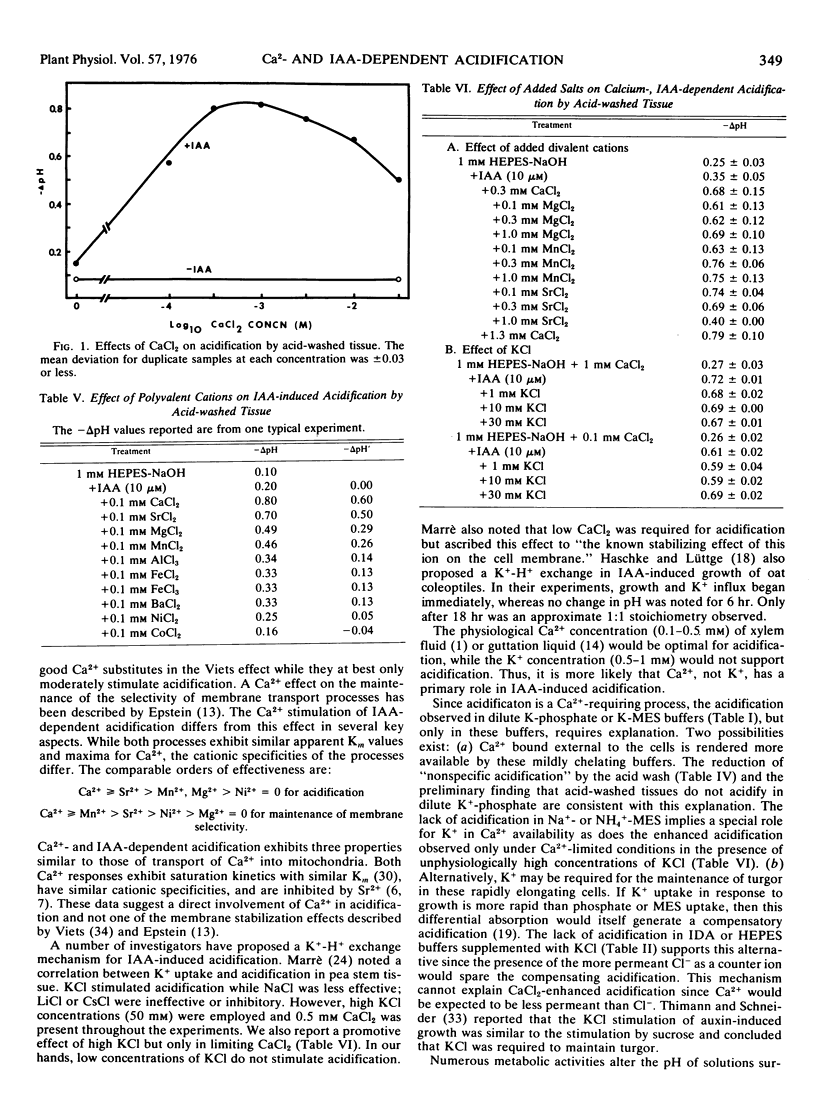Abstract
The ionic specificity of IAA-induced acidification by Avena coleoptiles was studied, using zwitterionic, presumably impermeant buffers. The acidification was almost totally dependent on divalent cations with an order of effectiveness of Ca2+ ≥ Sr2+ > Mn2+, Mg2+; whereas other polyvalent cations tested were ineffective. The Ca2+ response was IAA-dependent. The CaCl2 concentration was optimal at 0.3 to 1 mm and inhibitory at higher concentrations. Sr2+ inhibited Ca2+-dependent acidification and monovalent cations such as K+ did not induce additional acidification in the presence of optimal CaCl2. These data are consistent with a mechanism for IAA-induced acidification involving a Ca2+ −H+ exchange.
Full text
PDF



Selected References
These references are in PubMed. This may not be the complete list of references from this article.
- Anderssen F. G. SOME SEASONAL CHANGES IN THE TRACHEAL SAP OF PEAR AND APRICOT TREES. Plant Physiol. 1929 Oct;4(4):459–476. doi: 10.1104/pp.4.4.459. [DOI] [PMC free article] [PubMed] [Google Scholar]
- Carafoli E., Lehninger A. L. A survey of the interaction of calcium ions with mitochondria from different tissues and species. Biochem J. 1971 May;122(5):681–690. doi: 10.1042/bj1220681. [DOI] [PMC free article] [PubMed] [Google Scholar]
- Cleland R. Auxin-induced hydrogen ion excretion from Avena coleoptiles. Proc Natl Acad Sci U S A. 1973 Nov;70(11):3092–3093. doi: 10.1073/pnas.70.11.3092. [DOI] [PMC free article] [PubMed] [Google Scholar]
- Epstein E. The essential role of calcium in selective cation transport by plant cells. Plant Physiol. 1961 Jul;36(4):437–444. doi: 10.1104/pp.36.4.437. [DOI] [PMC free article] [PubMed] [Google Scholar]
- Goatley J. L., Lewis R. W. Composition of guttation fluid from rye, wheat, and barley seedlings. Plant Physiol. 1966 Mar;41(3):373–375. doi: 10.1104/pp.41.3.373. [DOI] [PMC free article] [PubMed] [Google Scholar]
- Good N. E., Winget G. D., Winter W., Connolly T. N., Izawa S., Singh R. M. Hydrogen ion buffers for biological research. Biochemistry. 1966 Feb;5(2):467–477. doi: 10.1021/bi00866a011. [DOI] [PubMed] [Google Scholar]
- JACKSON P. C., ADAMS H. R. Cation-anion balance during potassium and sodium absorption by barley roots. J Gen Physiol. 1963 Jan;46:369–386. doi: 10.1085/jgp.46.3.369. [DOI] [PMC free article] [PubMed] [Google Scholar]
- Rayle D. L., Cleland R. Enhancement of wall loosening and elongation by Acid solutions. Plant Physiol. 1970 Aug;46(2):250–253. doi: 10.1104/pp.46.2.250. [DOI] [PMC free article] [PubMed] [Google Scholar]
- Rayle D. L., Haughton P. M., Cleland R. An in vitro system that simulates plant cell extension growth. Proc Natl Acad Sci U S A. 1970 Dec;67(4):1814–1817. doi: 10.1073/pnas.67.4.1814. [DOI] [PMC free article] [PubMed] [Google Scholar]
- Viets F. G. CALCIUM AND OTHER POLYVALENT CATIONS AS ACCELERATORS OF ION ACCUMULATION BY EXCISED BARLEY ROOTS. Plant Physiol. 1944 Jul;19(3):466–480. doi: 10.1104/pp.19.3.466. [DOI] [PMC free article] [PubMed] [Google Scholar]


